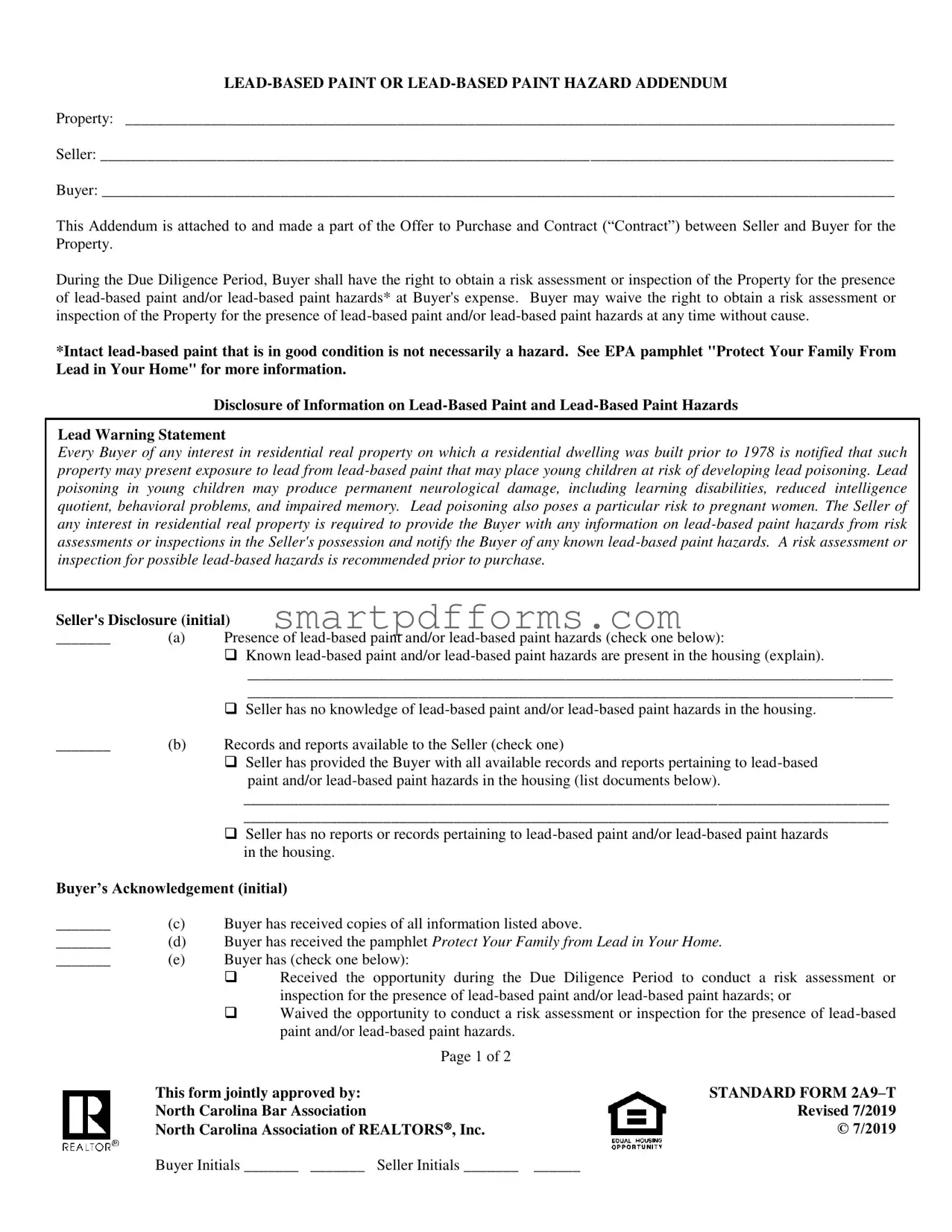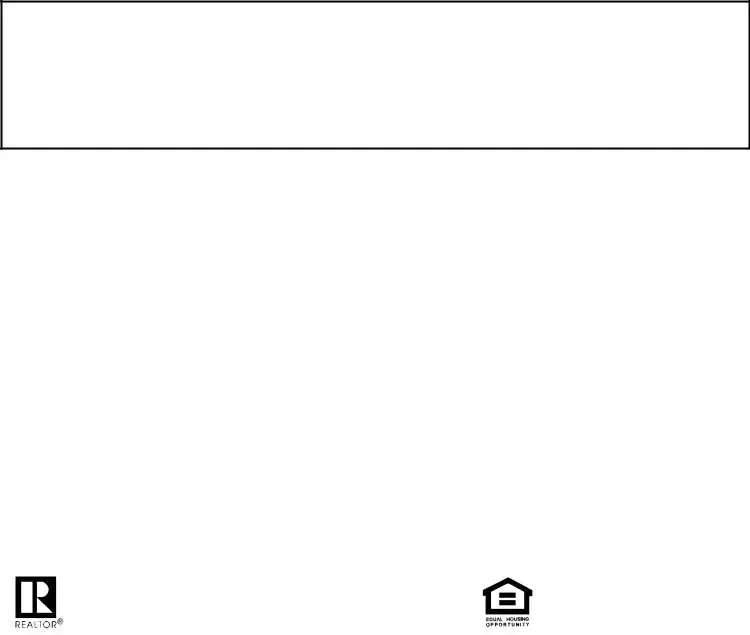LEAD-BASED PAINT OR LEAD-BASED PAINT HAZARD ADDENDUM
Property: ___________________________________________________________________________________________________
Seller: ______________________________________________________________________________________________________
Buyer: ______________________________________________________________________________________________________
This Addendum is attached to and made a part of the Offer to Purchase and Contract (“Contract”) between Seller and Buyer for the Property.
During the Due Diligence Period, Buyer shall have the right to obtain a risk assessment or inspection of the Property for the presence of lead-based paint and/or lead-based paint hazards* at Buyer's expense. Buyer may waive the right to obtain a risk assessment or inspection of the Property for the presence of lead-based paint and/or lead-based paint hazards at any time without cause.
*Intact lead-based paint that is in good condition is not necessarily a hazard. See EPA pamphlet "Protect Your Family From Lead in Your Home" for more information.
Disclosure of Information on Lead-Based Paint and Lead-Based Paint Hazards
Lead Warning Statement
Every Buyer of any interest in residential real property on which a residential dwelling was built prior to 1978 is notified that such property may present exposure to lead from lead-based paint that may place young children at risk of developing lead poisoning. Lead poisoning in young children may produce permanent neurological damage, including learning disabilities, reduced intelligence quotient, behavioral problems, and impaired memory. Lead poisoning also poses a particular risk to pregnant women. The Seller of any interest in residential real property is required to provide the Buyer with any information on lead-based paint hazards from risk assessments or inspections in the Seller's possession and notify the Buyer of any known lead-based paint hazards. A risk assessment or inspection for possible lead-based hazards is recommended prior to purchase.
Seller's Disclosure (initial)
_______ |
(a) |
Presence of lead-based paint and/or lead-based paint hazards (check one below): |
Known lead-based paint and/or lead-based paint hazards are present in the housing (explain).
___________________________________________________________________________________
___________________________________________________________________________________
Seller has no knowledge of lead-based paint and/or lead-based paint hazards in the housing.
_______ |
(b) |
Records and reports available to the Seller (check one) |
|
|
Seller has provided the Buyer with all available records and reports pertaining to lead-based |
|
|
paint and/or lead-based paint hazards in the housing (list documents below). |
___________________________________________________________________________________
___________________________________________________________________________________
Seller has no reports or records pertaining to lead-based paint and/or lead-based paint hazards in the housing.
Buyer’s Acknowledgement (initial)
_______ |
(c) |
Buyer has received copies of all information listed above. |
_______ |
(d) |
Buyer has received the pamphlet Protect Your Family from Lead in Your Home. |
_______ |
(e) |
Buyer has (check one below): |
Received the opportunity during the Due Diligence Period to conduct a risk assessment or inspection for the presence of lead-based paint and/or lead-based paint hazards; or
Waived the opportunity to conduct a risk assessment or inspection for the presence of lead-based paint and/or lead-based paint hazards.
Page 1 of 2 |
|
This form jointly approved by: |
STANDARD FORM 2A9–T |
North Carolina Bar Association |
Revised 7/2019 |
North Carolina Association of REALTORS, Inc. |
© 7/2019 |
Buyer Initials _______ _______ Seller Initials _______ |
______ |
Agent's Acknowledgment (initial)
______ |
(f) |
Agent has informed the Seller of the Seller's obligations under 42 U.S.C. 4852d and is aware of |
|
|
|
his/her responsibility to ensure compliance. |
|
|
|
|
Certification of Accuracy
The following parties have reviewed the information above and certify, to the best of their knowledge, that the information provided by the signatory is true and accurate.
IN THE EVENT OF A CONFLICT BETWEEN THIS ADDENDUM AND THE CONTRACT, THIS ADDENDUM SHALL CONTROL, EXCEPT THAT IN THE CASE OF SUCH A CONFLICT AS TO THE DESCRIPTION OF THE PROPERTY OR THE IDENTITY OF THE BUYER OR SELLER, THE CONTRACT SHALL CONTROL.
THE NORTH CAROLINA ASSOCIATION OF REALTORS, INC. AND THE NORTH CAROLINA BAR ASSOCIATION MAKE NO REPRESENTATION AS TO THE LEGAL VALIDITY OR ADEQUACY OF ANY PROVISION OF THIS FORM IN ANY SPECIFIC TRANSACTION. IF YOU DO NOT UNDERSTAND THIS FORM OR FEEL THAT IT DOES NOT PROVIDE FOR YOUR LEGAL NEEDS, YOU SHOULD CONSULT A NORTH CAROLINA REAL ESTATE ATTORNEY BEFORE YOU SIGN IT.
Date: _______________________ |
Date: _______________________ |
Buyer: ___________________________________________ |
Seller: ____________________________________________ |
Date: _______________________ |
Date: _______________________ |
Buyer: ___________________________________________ |
Seller: ____________________________________________ |
_________________________________________ |
__________________________________________________ |
Entity Buyer: |
Entity Seller |
_________________________________________________ |
__________________________________________________ |
(Name of LLC/Corporation/Partnership/Trust/etc) |
(Name of LLC/Corporation/Partnership/Trust/etc) |
By: ______________________________________________ |
By: _______________________________________________ |
Name: ____________________________________________ |
Name:_____________________________________________ |
Print Name |
Print Name |
Title: _____________________________________________ |
Title: _____________________________________________ |
Date: _______________________ |
Date: ________________________ |
__________________________________________________ |
__________________________________________________ |
Selling Agent: _____________________________________ |
Listing Agent: ______________________________________ |
|
Date: _______________________ |
Date: ________________________ |
|
Page 2 of 2
STANDARD FORM 2A9-T Revised 7/2019 © 7/2019


